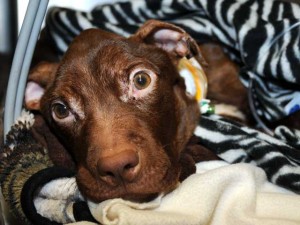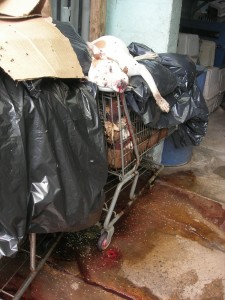A little dog named Patrick, discarded and left for dead, has captured the heart of a nation. His plight, and the outpouring of concern from all regions of the globe, also reverberated within city hall where Newark Mayor Cory Booker announced his desire to build “Patrick’s Place,” a No Kill shelter for the city in his name. According to the Mayor,
Recently a heinous incident of animal cruelty took place in our city and shocked the world. On March 16th, the day before St. Patrick’s Day, a 1-year-old pit bull was found inside a trash bag, starved and near death after having been thrown down a trash chute. At the time of his rescue by a heroic and caring maintenance worker, he weighed only 20 pounds — less than half of what doctors considered normal weight. He was quickly transferred to a trauma unit at Garden State Veterinary Specialists in Tinton Falls, New Jersey, where they found him to be severely anemic and malnourished, requiring a blood transfusion in order to survive. For his miraculous recovery and the holiday on which he was found, he has been dubbed “Patrick the miracle dog.” Despite his horrific abuse, Patrick is expected to recover fully into a happy, healthy dog.
Patrick’s story is one of countless instances of animal cruelty taking place daily around the world. It is a reminder that many animals suffer appalling abuse, and without our help, cases like this will end even more tragically. It is my hope that through spreading awareness and working together, we can help save many of these defenseless animals from abuse and neglect.
For almost two years, my administration has been working hard to establish a state-of-the-art animal shelter in Newark. Thus far, we have identified and are preparing a site, and have architects working on the design. This facility seeks to serve other New Jersey municipalities in Essex and Hudson counties that desperately need other options for housing and caring for homeless animals. By working to build a modern, state-of-the-art shelter through public and private funding, and by employing innovative policies to improve responsible pet care, decrease birthrates, increase adoptions, and help keep animals with their responsible caretakers, we believe that Newark’s animal shelter operations can become a model for the rest of the nation. Our ambitious goal is to one day be able to save every savable dog and cat in this new shelter.
For my birthday, my wish is that you join our cause to help spread awareness of Patrick’s story and animal abuse, and, if possible, contribute toward the construction of “Patrick’s Place” — the animal shelter which we hope to build in Newark. Patrick’s abuser claimed she could no longer care for her dog — it is our hope that by providing this additional facility in our city, more animals can be rescued from unnecessary neglect and abuse. Any money we raise not used for this project will be donated to a local organization for the protection and care of animals.
Newark will be known as a city that cares not only about its people, but its animals, too.
There is every reason to take Mayor Booker at his word. Under Mayor Booker’s leadership, the City of Newark has been dedicated to caring for and providing opportunities for the people of the city and in the process has become a national model of urban transformation. The Booker Administration completed a $40 million overhaul of the City’s parks and playgrounds. Affordable housing production has doubled. Model programs for returning ex-offenders have been created. And a dramatic transformation of the Newark Police Department has led to Newark helping set the nationwide pace for crime reduction since 2006. As a result, Time named him one of the 100 most influential people in the world.
It is those same principles of dignity, compassion, effectiveness, transparency, and accountability which he appears to want to bring to the new shelter. And he is on solid ground. Today, in communities across the country, there are cities which are saving all healthy and treatable animals. They are providing medicine for those who are sick, TLC for those who are traumatized, a loving, new home for those who have lost theirs. These shelters are saving over 90% of all animals in their open admission municipal shelters, reserving killing for those who are hopelessly ill or injured, irremediably suffering, and in the case of dogs, truly vicious with a poor prognosis for rehabilitation. What they are not doing is simply killing animals because someone says they are “unwanted” or there are “too many.”
There are some who say it cannot be done. Experience proves they are wrong. There are successful No Kill communities across the country. And they have become successful by implementing programs like low-cost spaying and neutering, partnering with rescue organizations, utilizing volunteers and volunteer foster homes, comprehensive adoption programs including using the Internet, social media, and offsite adoption locations, pet retention programs to help people overcome the medical, behavioral, and environmental conditions which cause them to relinquish their animals, and more. But most of all, they are doing it because they believe in their community and the power of the public’s compassion.
But not everyone is applauding. In fact, one group is fighting back: The Associated Humane Society (AHS) in New Jersey, the shelter which originally took custody of Patrick. They are threatening litigation against those who use Patrick’s likeness or photographs to save lives, even while they fundraise relentlessly on his case. They have condemned Mayor Booker for trying to build a No Kill shelter, saying No Kill is a sham and equating it with “warehousing.” And they have recently filed a motion in court demanding custody of Patrick even though he is in the care of a veterinarian who has nursed him back to health and he is wanted by a caregiver there who bonded with him.
Their position is ironic for three reasons. No Kill communities exist so it is hard to argue it is impossible in the face of success across the country. But even if they were right, even if we were to ignore history and the success of others, what is wrong with trying? What is wrong with moving toward the goal? We would save thousands of animals who would otherwise be killed. The public’s response to Patrick’s plight shows people to be kind, caring, and generous. And for the animals of Newark, and the people who love them, it is worth trying.
It is ironic, too, because accusing No Kill advocates of promoting “warehousing” is a classic case of the pot calling the kettle black given that AHS has a long, sordid history of warehousing and killing animals. In 2003, The State Commission of Investigation “released the results of a wide-ranging investigation into waste and abuse by one of New Jersey’s leading nonprofit animal-shelter organizations, Associated Humane Societies (AHS). The Commission found that AHS officials over the years have engaged in questionable financial practices, conflicts of interest, mismanagement and negligent animal care to the extent that the organization effectively lost sight of its core mission. Despite huge and highly successful fund-raising campaigns, the Commission found, “the history of AHS’s shelter operation has been dominated by deplorable kennel conditions, inhumane treatment of animals by workers, mismanagement and nonexistent or inadequate medical care.” The Commission’s findings, going back to the 1980s, included: “Accountability so lax that millions of dollars accumulated in AHS cash and investment accounts while the care and feeding of sick and injured animals went begging” and “Deplorable shelter conditions and inadequate or absent veterinary care for shelter animals.”
Despite the 2003 findings, state animal welfare inspectors found even more deplorable conditions for animals in 2009, including “severe fly and maggot infestation,” “overwhelming malodorous smell,” “large amount of blood was found splattered on the floor, walls, and viewing window,” sick and injured animals “not being treated.” Animals “exhibiting signs of severe bloody, watery diarrhea and lethargy : not separated or receiving treatment.” Of the 4,296 cats taken in, 2,721 were put to death. Another 616 either died or are missing. Of the 3,423 dogs taken in, 806 were killed. Another 60 either died or are missing.
And while AHS takes great pains to say that these conditions are all in the past, this year, given the widespread and abusive problems going back to the 1980s as documented in the State Commission of Investigation inspection of 2003 and the 2009 inspection, state investigators should have found a pristine shelter. They did not. Even in 2011, kennel staff were still hosing down the kennel hallway with chemicals and water with the dogs still inside their cages, “further exposing them to contaminates and spray from the hoses.” Even in 2011, there is evidence that they do not clean or disinfect the automatic feeders because there are layers of caked on food. Even in 2011, “Some animals displaying signs of illness are not being provided with prompt medical care.” Even in 2011, “[S]ick shelter animals [are] intermixed with owned animals in the public medical room.” In addition, some of those who were in charge in 2003, who were in charge of 2009, and who allowed those conditions to occur, are still in charge in 2011. Even in 2011, while communities across the country have invested in modern housing facilities, AHS continues to house the animals in dilapidated, even dangerous, conditions. You do not wait for a roof to collapse to replace it. You do not wait for a state inspection report to tell you rotted food in the automatic dispensers is bad to discard it.
Even if one were to accept the premise that things are better, they are not great. The animals deserve great. And with over $8,000,000 in revenue annually, they can afford great. In addition, the goal is not just keeping them comfortable before they are killed. The goal is also to save their lives. While communities across the country have achieved 90% and better rates of lifesaving, AHS continues to kill animals because it will not employ common-sense, innovative, cost-effective programs like foster care. This is a death sentence for too many animals.
And, finally, it is ironic because as a “humane” society, they should desire what is best for Patrick. And, in my humble opinion, that is to stay with those who brought him back from the brink of death, who patiently cared for him, nursed him, loved him, who desire to give him a lifelong, loving home, and with whom Patrick has bonded. Hasn’t Patrick suffered enough?
And so while Patrick has captured the heart of his nurse and the heart of a nation, he appears to have hardened that of the Associated Humane Societies. The shelter has launched a campaign of intimidation, fear-mongering about No Kill, threatening lawsuits, and demanding custody of Patrick. But the Mayor of Newark is fighting back. According to an attorney for the City, the Mayor has ordered Associated Humane Society to take no further action with regards to Patrick. Patrick should stay with the veterinarian who is caring for him and should be adopted by the caregiver who he has bonded with. That is what is best for Patrick, even if it is not in the best interests of Associated Humane Society’s pocket book.
A photograph from the 2009 state inspection of AHS in Newark: a dead dog, bleeding, whose body and floor is teeming with maggots. To view the rest of the photographs, click here. (Warning: Very graphic.)

